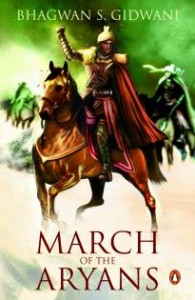In his latest book – March of the Aryans – published by Penguin Books India, Bhagwan S. Gidwani takes us, again, back to the dawn of civilization (8000 BCE) to recreate the fascinating story of the Birth and Beginnings of Hinduism (Sanatan Dharma), with a thrilling account of how, in 5000 BCE, the Aryans originated from India, (and from nowhere else) – and why they moved out of their home-land; their courage, rashness, heroic thrusts, battles, bloodshed, failures and triumphs in the far distant regions of Asia and Europe and finally, their triumphant return to their homeland and heritage of India.
Bhagwan S. Gidwani, based now in Montreal, was India’s Additional General of Tourism and Director General of Civil Aviation till 1978. He served as India’s Counsel at the International Court of Justice at the Hague and as Representative of India at the Council of ICAO (United Nations) from 1978 to 1981.
Gidwani is the author of the novel The Sword of Tipu Sultan, which was translated in many languages and made into a major TV Serial for which Gidwani also wrote the script and screenplay. His previous novel Return of the Aryans was also highly successful. March of the Aryans is adapted from that novel.
Saga of ancient India
Vast and absorbing, with a cast of thousands, March of the Aryans is gripping tale of kings and poets, seers and hermits, battles and romance and the rise and fall of civilizations. Here are characters like the gentle god Sindhu Putra, spreading his message of love, the hermit Bharat who inspired the dream of unity, equality, human rights and dignity for all; physician sage Dhanawantar and his wife Dhanawantari, peace-loving Kashi after whom the holy city of Varanasi was named; and Nila who gave his name to the river Nile in Egypt.
March of the Aryans shows that Aryans were born, grew up, and died as citizens of Bharat Varsha (India), anchored in the timeless foundation of Hindu faith. The author demolishes the theory of North/South Divide, and shows how the people of Ganga, Madhya, Sindhu, Bangla and other regions were together with the Dravidian regions, in a spirit of equality and mutual respect, as a part of Bharat Varsha (India).
Story of Indian civilisation
In unfolding the dramatic story of Indian civilization, Gidwani presents glimpses of art, culture, music, abstract thought, philosophical leanings, and spiritual values of pre-history India. The work reveals dramatic stories behind the origins of Om, Namaste, Swastika, Gayatri Mantra, and Soma Wines. It tells how Tamil and Sanskrit developed, and how they influenced world-languages; also it has tales of discovery and disappearance of Saraswati River; the battles and blood-shed that led to fall and rise of many ancient cities.
Besides, Gidwani sheds light on pre-history establishment of Hindu Parliament; legal establishment of Hindu Parliament; legal & constitutional systems; development of ships & harbours; gold-mining; chariots; Yoga; mathematics; astronomy; medicine; surgery; music, dance, drama, art & architecture; and material advancement of the pre-ancient India.
The book speaks of ideals that took shape in those early times, to become the foundation of Sanatana Dharma – and among those ideals were: recognition of spiritual nature of man wherever he is from; acceptance of every culture as an expression of eternal values; and man’s obligation to respect and protect environment, and all creatures, tame and wild.
March of the Aryans
By: Bhagwan S. Gidwani
ISBN- 978-0-143-41898-6
Publisher: Penguin Books, India; July 15, 2012
Language: English
No of Pages: 680


Leave a Reply